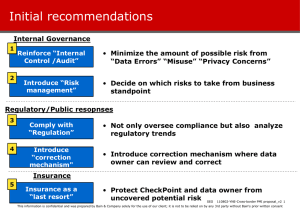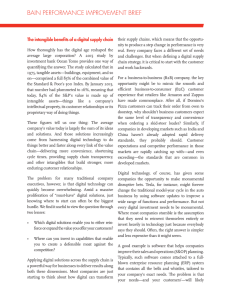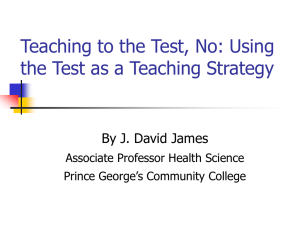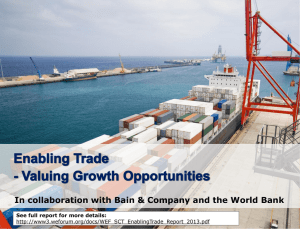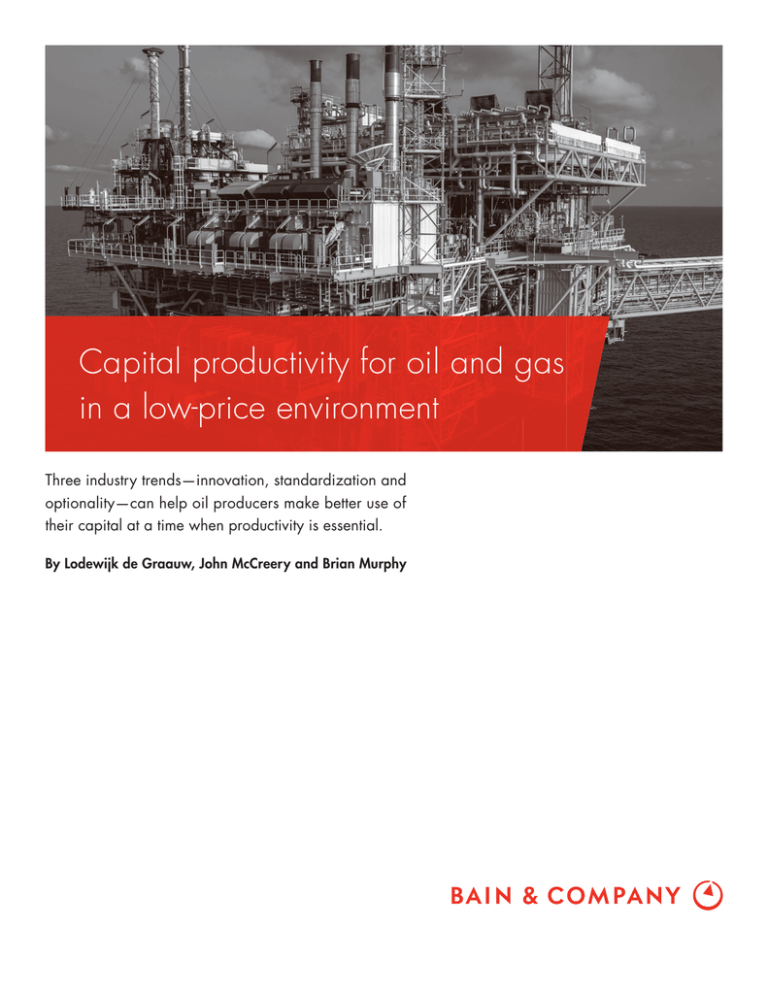
Capital productivity for oil and gas
in a low-price environment
Three industry trends—innovation, standardization and
optionality—can help oil producers make better use of
their capital at a time when productivity is essential.
By Lodewijk de Graauw, John McCreery and Brian Murphy
Lodewijk de Graauw and Brian Murphy are partners with Bain & Company
in Perth. John McCreery is a Bain partner in Houston. All three work with
Bain’s Global Oil & Gas practice, and Brian leads the practice in the AsiaPacific region.
Copyright © 2015 Bain & Company, Inc. All rights reserved.
Capital productivity for oil and gas in a low-price environment
won over capital efficiency, resulting in a tripling of annual capex between 2003 and 2013. In the $50-per-barrel
world, projects will increasingly struggle to return the
cost of capital, so capital efficiency will be essential to
get projects funded.
Reducing capital expenditure is a natural response to low
oil prices, as demonstrated by the oil and gas industry
deferring or canceling $200 billion worth of planned
investments over the past two years. Another $1.5 trillion of future spending may be uneconomic at current
oil prices.
Three fundamental trends to improve capital productivity
At the same time, the industry needs to continue to
explore and develop to meet long-term demand, which
continues to grow, albeit more slowly than before. In fact,
over the past decade, major oil companies have had to
invest more capital just to maintain production levels,
running harder to stand still (see Figure 1).
Fortunately, oil and gas companies have room to raise
their capital productivity, particularly for projects that
are early in the life cycle. We see three broad trends that
will fundamentally raise the productivity of capital
over the coming decades: innovation, standardization
and optionality.
As the industry establishes a new equilibrium between
supply and demand, producers shift from high-cost plays
(such as Arctic and ultra-deepwater) to more accessible,
low-cost barrels (see Figure 2).
Innovation. Technology continues to evolve rapidly in
oil and gas, improving capital productivity by delivering
solutions that help producers deliver more efficiently.
The technologies that helped make unconventional production economical over the past decade are the most
obvious example. Floating liquefied natural gas (FLNG)
platforms are another one. These structures will improve
In this low-cost world, it will be even more important
to use capital as efficiently as possible. When oil was
$100 per barrel, projects competed against each other
for capital, but high returns meant that volume typically
Figure 1: Running to stand still: Oil majors have had to spend more just to keep pace with production
Upstream investment by international oil companies
(billions of dollars)
300
13
200
12
FY 2014
10
11
08
2015
06
09
07
05
100
FY 2002
03
04
0
20
21
22
Production (millions of barrels of oil equivalent per day)
Notes: Fiscal years 2002–2014; international oil companies included BP, Chevron, ConocoPhillips, ENI, ExxonMobil, Shell, Statoil and Total
Source: Datastream (September 16, 2015)
1
23
Capital productivity for oil and gas in a low-price environment
Figure 2: As the break-even price drops, production momentum shifts to lower-cost production areas
Global oil production supply curve
Break-even price
(per barrel)
$125
100
September 2014 Brent price
75
Permian tight
Gas to liquid
Asia deepwater
Coal to liquid
South American deepwater
Arctic
Canadian Oil Sands
North American deepwater
Venezuela extra heavy
Europe
North America conventional
Bakken
Eagle Ford
EOR
Australia and Pacific
50
Asia conventional
September 2015 Brent price
So. America (Non-OPEC)
25
OPEC, Middle East and Africa
Russia and CIS
0
20
40
60
80
Production (millions of barrels per day)
Notes: Break-even price assumes a 10% return and a net present value of 0; CIS=Commonwealth of Independent States; EOR=enhanced oil recovery
Sources: IEA World Energy Outlook; EIA International Energy Outlook; EIA Annual Energy Outlook; Morgan Stanley
the economics of remote natural gas production as they
begin to replace traditional onshore development projects. Advanced analytics will help, too, by improving the
predictability of known drilling problems in well planning and execution. When oil prices are low, technology
budgets come under severe pressure, so executives
should take care not to damage their long-term capacity
for innovation.
Second, the “design one, build many” concept has had
some notable successes, with ExxonMobil’s deepwater
developments in Angola often cited as the best example.
The industry could do more under this concept—for
example, in FLNG.
Standardization also makes it easier for companies to
collaborate and eliminate wasteful practices. This is especially true as most development over the next five years
will be within known environments (since ultra-deepwater and the Arctic are mostly off the table at today’s
oil prices), and companies can continue down the experience curve (see Figure 3).
Standardization. Industries such as automotive and
manufacturing have worked to standardize their production processes, but that has not occurred in oil and
gas. Consider subsea operators who still use 28 different
shades of yellow to paint their equipment. Standardization improves capital productivity in several ways. First,
simplifying and standardizing engineering designs
helps prevent unnecessary customization and the urge
to gold-plate solutions. One senior executive applies this
test: If the new idea were to cost 10 times what the proponent says and the benefit were to be one-tenth of that
claimed, would we still do it? Only changes passing the
test are implemented.
Optionality. For almost 20 years, the industry has worked
with decision review gates and a sequential, converging
process for project development: a review of conceptual
options followed by front-end engineering of one selected
option before making a final investment decision and
commencement of a detailed design. This approach has
served the industry well and should continue to do so.
2
Capital productivity for oil and gas in a low-price environment
Figure 3: Tight oil production moves down the experience curve, reducing the cost to produce a barrel of oil
Eagle Ford tight oil drilling rig costs
(per barrel)
$100
50
20
10
Costs decline by 16% with each
doubling of cumulative production.
5
2
1
0.1
0.2
0.5
1
2
5
10
20
50
100
200
Cumulative production (millions of barrels)
Note: Well cost is weighted average well cost, pads and single wells
Sources: Continental Resources; RBC Eagle Ford shale performance; IHS Cera, EIA; Bain analysis
receive less attention, but the project should maintain
a clear understanding of the assumptions underpinning
that outcome and monitor the external environment
for changes.
Today’s environment places pressure on that process.
Markets are volatile, and innovation is accelerating rapidly. Pressure on capital productivity leaves less tolerance
for long rework cycles, and if a project fails to pass a
stage gate, that may be the end of it.
None of this advocates for looser or schedule-driven
early-stage development, which can be a train wreck.
Project developers still need to make decisions based
on value creation and with all due technical and commercial consideration. But projects can proceed with
explicit treatment of uncertainty, taking a “wider funnel for longer” at the start with a flexible stage gate
system, guided by an appropriately senior gatekeeper.
We see two implications from this, both of which may
require the judgement of more senior project development executives.
First, companies can learn to make decisions based on
imperfect but sufficient information. Too often, they
overinvest in defining conceptual designs to reach an outcome that could have been decided more easily. Instead,
they can reverse the logic and start with what would be
needed for the project to fly. If the cost is off by billions,
there’s no need to examine smaller details. Instead, they
can move on to alternative concepts.
Putting capital productivity into motion
These trends are well documented, but industry leaders
will have to focus their efforts to ensure that they contribute to capital productivity within their organizations.
Five principles can guide executives as they make capital decisions.
Second, they should keep more options open in the
early stages, pursuing multiple concepts in competition with each other. Suboptimal options should
3
Capital productivity for oil and gas in a low-price environment
•
Continue to invest. Current conditions represent an
opportunity to invest in capital projects in a low-price
environment, to make progress on projects while
sector inflation takes a breather and people and
equipment are less in demand. The opportunity applies to R&D, too, even though reduced revenue puts
pressure on budgets. Companies need to prioritize
carefully to ensure that they continue to fund technologies that could reduce costs and make challenging opportunities affordable.
•
Design to cost. Too many capital projects start with
a cost estimate defined by the engineering and design teams. Taking the reverse approach—that is,
understanding what investment is feasible and then
deciding what can be done within those constraints—
is more realistic in a low-oil-price environment. In
fact, setting the cost below a reasonable level spurs
creativity and preserves capital until oil prices recover.
•
•
•
Look for opportunities in every step of the process.
Project teams have many ways to improve the productivity of capital, including scope reduction, construction excellence and more efficient procurement.
Too often, they review these opportunities only before
major decision gates, or after an unsuccessful visit
to one. Instead, similar to an operating asset, the
development project itself needs a constant improvement process. Opportunities to optimize value need
to be managed throughout opportunity generation,
prioritization, solution generation and implementation. Project leaders should resource and govern
these to add value to, rather than slow down, the
overall project process.
Working across all these principles, companies can reduce
capex significantly. One major integrated oil company
was able to reduce the capital spending costs of a major
platform in the Gulf of Mexico by 36% through reengineering work that suggested better productivity was
possible from using a subsea platform. In another example, a national oil company cut the time necessary for
drilling a well by more than 40%, from 146 days to 83
days, by avoiding side efforts and focusing on better
planning and execution.
Collaborate to drive standardization. Internally, companies should adopt best-in-class design objects and
measure the uptake of reusable designs from standard catalogs. Externally, companies should be more
open to (closely monitored) collaboration with vendors, engineering and procurement contractors,
and owner teams to engage collectively in standard,
productive solutions. Decision processes and tools
that streamline partner interactions and approvals
can also help.
As executives work to improve their capital productivity
in this low-price environment, they need to remain nimble, pairing the engineering and commercial mindsets
where they can, managing the organization toward simplicity and standardization, and maintaining a healthy
appetite for investment rather than deferment. Few forecasts suggest a strong price recovery in the medium term,
so the need for capital productivity is here to stay.
Challenge the development process. The traditional
stage gate process looks increasingly regimented
and slow in an industry with volatile prices, shifting
markets and accelerating innovation. More agile and
iterative methods may be more effective in supporting design to cost, and some industry leaders are
experimenting with shorter time periods, parallel
processes and rapid development methodologies
such as agile and scrum. Others worry that rushing
forward without proper review could be disastrous
for projects and organizations. Most are trying to
get the balance right so that their organizations can
be productive but also efficient.
4
Are you maximizing your capital productivity?
•
Do you have a complete view on the latest innovations relevant to your project, and have you
adopted them where appropriate?
•
Is your company investing sufficiently in developing proprietary technology?
•
Are your engineering efforts delivering the certainty you need at the next stage gate decision?
•
Do you have a clear view on the runner-up design options? What would need to change to make
those options the preferred ones?
•
Is your project design as simple as it can be? Can you justify all nonindustry standards?
•
Can you reuse any design components, either from this or previous projects?
•
Have you considered synergies with other projects in the region, not necessarily your own?
•
When was the last time you conducted a thorough review of your opportunity register, not just
the risk register?
Shared Ambit ion, True Results
Bain & Company is the management consulting firm that the world’s business leaders come
to when they want results.
Bain advises clients on strategy, operations, technology, organization, private equity and mergers and acquisitions.
We develop practical, customized insights that clients act on and transfer skills that make change stick. Founded
in 1973, Bain has 53 offices in 34 countries, and our deep expertise and client roster cross every industry and
economic sector. Our clients have outperformed the stock market 4 to 1.
What sets us apart
We believe a consulting firm should be more than an adviser. So we put ourselves in our clients’ shoes, selling
outcomes, not projects. We align our incentives with our clients’ by linking our fees to their results and collaborate
to unlock the full potential of their business. Our Results Delivery® process builds our clients’ capabilities, and
our True North values mean we do the right thing for our clients, people and communities—always.
Key contacts in Bain’s Global Oil & Gas practice
Europe, Middle East and Africa
Lars Jacob Boe in Oslo (larsjacob.boe@bain.com)
Luca Caruso in Moscow (luca.caruso@bain.com)
Juan Carlos Gay in London (juancarlos.gay@bain.com)
Lili Chahbazi in London (lili.chahbazi@bain.com)
Christophe de Mahieu in Dubai (christophe.demahieu@bain.com)
Raed Kombargi in London (raed.kombargi@bain.com)
Torsten Lichtenau in London (torsten.lichtenau@bain.com)
Olya Linde in Moscow (olya.linde@bain.com)
Alain Masuy in Dubai (alain.masuy@bain.com)
Roberto Nava in Milan (roberto.nava@bain.com)
Peter Parry in London (peter.parry@bain.com)
Tiziano Rivolta in Milan (tiziano.rivolta@bain.com)
Alasdair Robbie in London (alasdair.robbie@bain.com)
Americas
Riccardo Bertocco in Dallas (riccardo.bertocco@bain.com)
Pedro Caruso in Houston (pedro.caruso@bain.com)
Ricardo Gold in São Paulo (ricardo.gold@bain.com)
Eduardo Hutt in Mexico City (eduardo.hutt@bain.com)
Jorge Leis in Houston (jorge.leis@bain.com)
Rodrigo Mas in São Paulo (rodrigo.mas@bain.com)
John McCreery in Houston (john.mccreery@bain.com)
John Norton in Houston (john.norton@bain.com)
Ethan Phillips in Houston (ethan.phillips@bain.com)
José de Sá in São Paulo (jose.sa@bain.com)
Asia-Pacific
Karim Shariff in Dubai (karim.shariff@bain.com)
Sharad Apte in Bangkok (sharad.apte@bain.com)
Natan Shklyar in Moscow (natan.shklyar@bain.com)
Francesco Cigala in Kuala Lumpur (francesco.cigala@bain.com)
John Smith in London (john.smith@bain.com)
Lodewijk de Graauw in Perth (lodewijk.degraauw@bain.com)
Matt Taylor in London (matt.taylor@bain.com)
Dale Hardcastle in Singapore (dale.hardcastle@bain.com)
Luis Uriza in London (luis.uriza@bain.com)
Brian Murphy in Perth (brian.murphy@bain.com)
Andrea Petronio in Milan (andrea.petronio@bain.com)
For more information, visit www.bain.com

